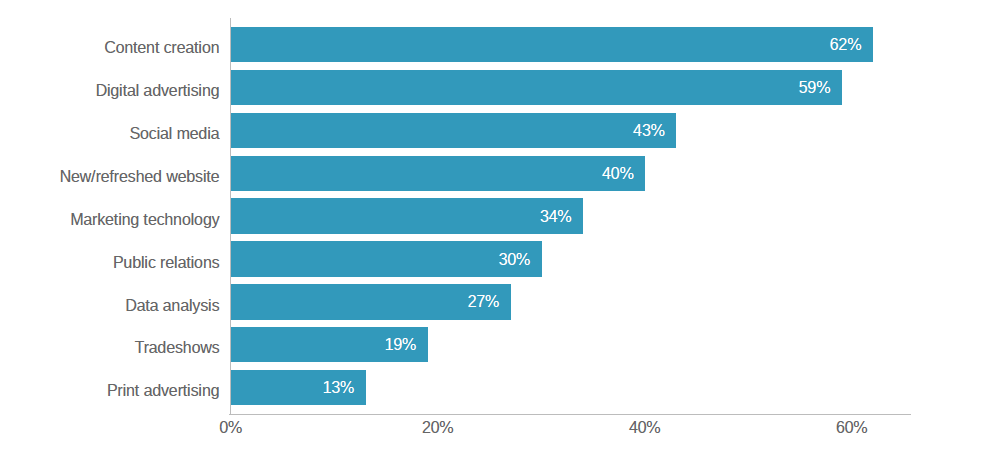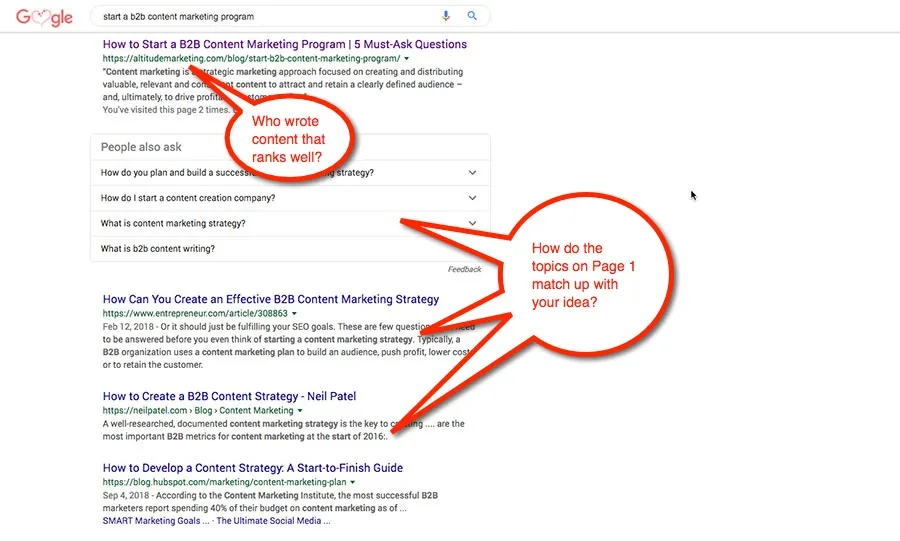If you’re like most marketers, you’re probably thinking about investing more in content creation. But before you put more eggs in the content marketing basket, you’d better make sure you know how to write a B2B blog post that aligns with 2025 best practices.

How to Write a B2B Blog Post [A No-BS Guide for Marketers]
Why is B2B blogging important? First and foremost, it’s a huge driver in organic SEO – Google loves great B2B blog posts. Plus, an active blog shows prospects you’re smart and capable of solving their problems.
The statistics bear out the importance of business-to-business blogging. We recently conducted a market research study of 100 B2B marketing professionals. Almost two-thirds said they plan to increase their investment in content creation in 2019.

More than half said they blog at least month, with forty-six percent producing multiple posts per month:

It’s hard to argue with those numbers. Clearly, blogging is here to stay on the Mount Rushmore of B2B marketing strategies.
Do you want to turn your blog into the linchpin of a great content marketing program? Here are five quick steps you need to know to write a B2B blog post that gets results.
Step 1: Pick a Topic
There are tons of examples of business-to-business bloggers getting stuck at this step. The trick is to not overthink it.
Consider what you do, and the problems you solve. Those problems are what your potential buyers are searching for! If you provide an answer, they’ll learn to trust you – and ultimately think about buying from you.
In other words, if you make employee scheduling software, give tips and templates to help managers schedule their employees. If your software helps police departments manage investigations, produce useful content for investigators.
What you shouldn’t do is get overly philosophical or cute. The last thing the web needs is more hot takes and pop culture connections. Readers want good, solid, actionable information.
Step 2: Think of a Focus Keyword
Once you have a general topic, it’s time to determine your focus keyword. This, according to Yoast SEO, is:
“THE SEARCH TERM THAT YOU WANT YOUR PAGE TO RANK FOR MOST. SO WHEN PEOPLE SEARCH FOR THAT PHRASE, THEY SHOULD FIND YOU.”
Picking a focus keyword, or keyphrase, is an art. It takes years to master it. But there is one tip that beginning B2B bloggers can use to get most of the way there.
Google it.
Seriously.
Think to yourself what your post is about, and Google that term. Then look at what content is returned on Page 1, and who wrote it.

Does the content look something like what you have in mind? If it does, you’re probably in good shape. But if it’s way off – like a different industry using the same phrase in a different way – you probably need to try something else.
If the Page 1 content is written companies much larger than you or massive content organizations, you probably need to use a longer or more specific focus keyword. If it’s companies around your size or smaller, you’re good to go.
The most important thing is that your focus keyword matches your content exactly. You can’t fool Google. Write the best content about your topic.
Here’s more on keyword strategy from Yoast:
Step 3: Think of Images
Yes, we’re advising that you think about images before you start writing. This is important for two reasons:
- It helps you focus and start to shape your content. If you have your screenshots, infographics or stock images selected ahead of time, you’re less likely to go off on tangents.
- If you don’t get images ready ahead of time, you’re going to want to post your content and move on to the next thing.
Images are critically important to B2B blog posts. They give the reader context and add information in an easy-to-parse format. Plus, Google loves them.
(Just don’t forget your alt text. People always forget the alt text.)
Step 4: Actually Write Your B2B Blog Post
This is actually the easiest step when we’re teaching someone how to write a B2B blog post.
If you’ve read Step 1, you know you should be writing about what you know. This isn’t a treatise on the state of the world, or an attempt to shoehorn “Jersey Shore: Family Vacation” into your industry.
It’s just what’s in your brain about a topic, translated into words on a page.
If you know how to do something that your prospects need to do, tell them how.
And if you know where to look for resources your prospects need, make a list.
If you know best practices or strategies are changing, tell them what the new ones are.
Writing a B2B blog post does not need to be a slog, even if you’re not a writer. Remember the KISS principle:
“KEEP IT SIMPLE, STUPID.”
Here are some tips for writing more effective B2B blog content:
- Write at least 600 words. The more comprehensive your content, the more value it will give readers.
- Try to keep sentences and paragraphs short. You want to be easy to read.
- Did we mention sticking to what you know? You’ll only come across like an expert if you are one.
- Keep it SFW. We really tried to get a “Jersey Shore” GIF in this section. Not happening.
- Have someone outside the industry read the post. Can they understand it? If not, it might be too hard to read.
Step 5: Tune It Up & Post It
At this stage, you’ve:
Identified a killer blog topic
Scoped out the competition and decided you can probably rank on Google
Added relevant and informative visuals
Written at least 600 words of good copy (hopefully without struggling)
Now all that’s left to do is tune it up and let it fly.
If you’re using WordPress, use the Yoast SEO plugin (ideally the premium one) and get both the Readability Analysis and Focus Keyphrase fields green and smiling, like this:

Remember, Yoast is only as good as the focus keyphrase you enter. It scores based on that. If your keyphrase is a non-starter – like if we used “blog” instead of “how to write a B2B blog post” for this one – you’re not going to rank, period.
If you don’t rank in organic search, nobody sees your post. And if nobody sees your post, you wasted your time. Bummer.
Other content management systems have their own search engine optimization tools:
- Drupal SEO Tools
- HubSpot SEO
- Joomla SEO Extensions
Once your SEO suite is happy, preview your post. Does everything look right? Are images where they should be? Any typos?
(Typos can actually hurt your SEO, believe it or not.)
Give your B2B blog post one final read and hit “publish.” You’re done!
Well, almost. Unless your site is a content monster (or live indexing is a real thing), Google won’t pick up your new post immediately.
Steps | Do’s | Don’ts |
1. Pick a Topic | Consider the problems you solve for your target audience and provide solutions. | Don’t overthink it or try to be too philosophical or “cute”. |
2. Think of a Focus Keyword | Google your potential topic and analyze the top results to determine a relevant keyword. Use a longer, more specific keyword if the top results are from much larger companies. | Don’t choose a keyword that doesn’t match your content. |
3. Think of Images | Select relevant images, screenshots, or infographics ahead of time to shape your content and provide context. | Don’t forget to include alt text for images. |
4. Write the Blog Post | Write at least 600 words, keep sentences and paragraphs short, stick to what you know, and have someone outside the industry review for readability. | Don’t make it too complicated or try to shoehorn irrelevant pop culture references. |
5. Tune It Up & Post It | Use an SEO plugin (like Yoast SEO) to optimize for your focus keyword, preview for errors, and publish. Submit the new post to Google Search Console to get it indexed. | Don’t publish without optimizing for SEO and checking for typos. |
How To Get Your New Content Indexed
ou can’t force the search engine to crawl or index your post, but you can ask it nicely using the URL Inspection Tool (the new version of Fetch as Google). Likewise, you can submit a new XML sitemap to Google Search Console.
Now you’re well and truly done. Sit back, give it a few hours (or a few days) and search for that focus keyphrase of yours.
If you’ve done it right, you’ll show up on the search engine results page. And if you see your result, your prospects will, too.
Happy blogging!
Don’t feel like learning how to write a B2B blog post yourself? No worries – you’re probably busy enough. Altitude’s content marketing team would be happy to lend a hand. Contact us online or give us a call at 610-421-8601 x122 to learn more about how we can use content to drive qualified business-to-business traffic and leads your way.
FAQs
How do I choose a good topic for my B2B blog post?
Think about the problems your business solves for customers. Write about those issues and provide helpful solutions. For example, if you sell employee scheduling software, share tips on scheduling staff efficiently. The key is to focus on topics your target audience cares about and can benefit from.
Why should I think about images before writing?
Having visuals like screenshots or infographics ready upfront can help guide your writing process. You’ll be less likely to go off on unrelated tangents. Plus, images make your content more engaging and easier to understand for readers.
How can I optimize my post for search engines?
Use an SEO plugin like Yoast SEO to ensure your post is well-optimized for your focus keyword. Check for readability issues and preview your post before publishing. Finally, submit your new content to Google Search Console to get it indexed faster.



